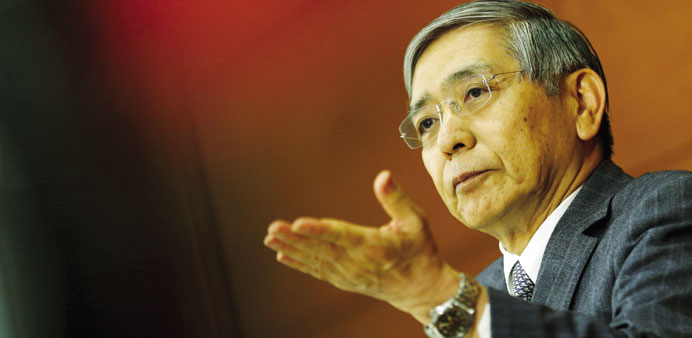Kuroda: Economy will recover moderately as global demand picks up.
Reuters/Tokyo
The Bank of Japan held off on expanding its massive stimulus programme yesterday, despite pushing back the timing for hitting its inflation target by six months, blaming the delay mostly on energy price falls rather than any weakness in the economy.
While BoJ governor Haruhiko Kuroda maintained his optimistic outlook, two board members dissented to the bank’s baseline scenario that inflation will reach 2% by 2017 – exposing a rift between pessimists and optimists in the nine-member policy board. At yesterday’s rate review, the BoJ maintained its pledge to increase base money, or cash and deposits at the central bank, at an annual pace of ¥80tn ($662bn) through aggressive asset purchases.
“This is what I would call decisive inaction on the part of the BoJ. They played this very much by the book, not leaving any room for confusion by waiting until after the market opened for its afternoon session,” said Stefan Worrall, cash equities manager at Credit Suisse in Tokyo.
Markets took the decision in stride with the Nikkei stock average rising to its highest in more than two months on news the government will compile an extra budget of over ¥3tn. The central bank, however, will remain under pressure to expand its already massive asset-buying programme as slumping energy costs, weak exports, and a fragile recovery in household spending keep inflation well short of its 2% target, analysts say. In a twice-yearly outlook report issued yesterday, the BoJ cut its forecasts and projected 0.1% inflation for the current fiscal year that began in April, followed by 1.4% inflation next year. It also pushed back the expected timing of achieving 2% inflation by six months, now projecting that price growth will hit the target in the latter half of the next fiscal year ending March 2017.
Kuroda said there was no discussion on easing policy at yesterday’s meeting and stressed that Japan’s economy will recover moderately as global demand picks up, staying on track to reach 2% inflation.
“The timing for achieving the price target has been delayed, but this is largely due to the effect of energy price falls,” Kuroda told a news conference.
“The price trend is improving steadily and inflation is likely to head towards 2% as the effect of oil price falls dissipates.” It was the third time the BoJ has postponed the timing on when it expects prices to hit the inflation target. Even though nearly three years is about to pass since the BoJ deployed its stimulus programme, Kuroda was unwilling to change the bank’s commitment to achieve its price goal in roughly two years.
“That commitment is key to ending deflation and the core of the policy effect of QQE,” Kuroda said, referring to his programme of quantitative and qualitative easing.
Japan’s economy contracted in April-June and may shrink again in July-September because of weak exports.
Core consumer prices, which exclude volatile fresh food but include oil costs, fell 0.1% in the year to September, a second monthly drop, and household spending slid even as job availability hit a two-decade high.
While market players were split on whether the BoJ would ease yesterday, many expect it to deploy stimulus early next year believing that growth will be too weak to generate inflation as quickly as the bank predicts.
Recognising overseas hazards to its forecasts, the BoJ report warned that China’s slowdown and sluggish emerging market demand posed “strong downside risks” to Japan’s recovery. Kuroda acknowledged that wage growth and capital expenditure spending had been weaker than expected, and reiterated the BoJ’s readiness to ease again if threats to improvements in the price trend emerged. While some board members worry about the dangers of extensive money printing, such concerns won’t prevent the BoJ from expanding stimulus further, Kuroda said.
“I don’t think there are limits to our policy options,” he said.



